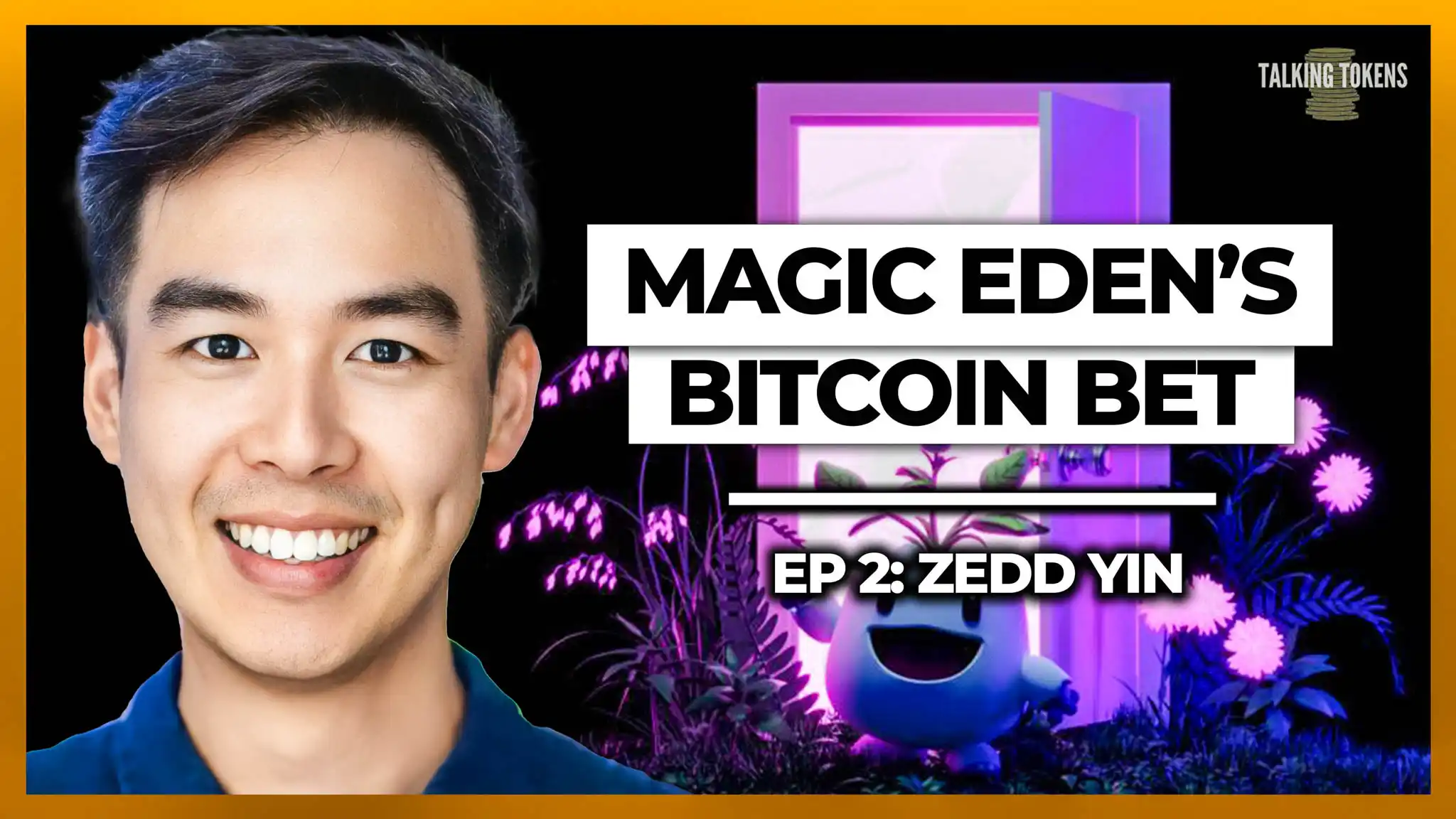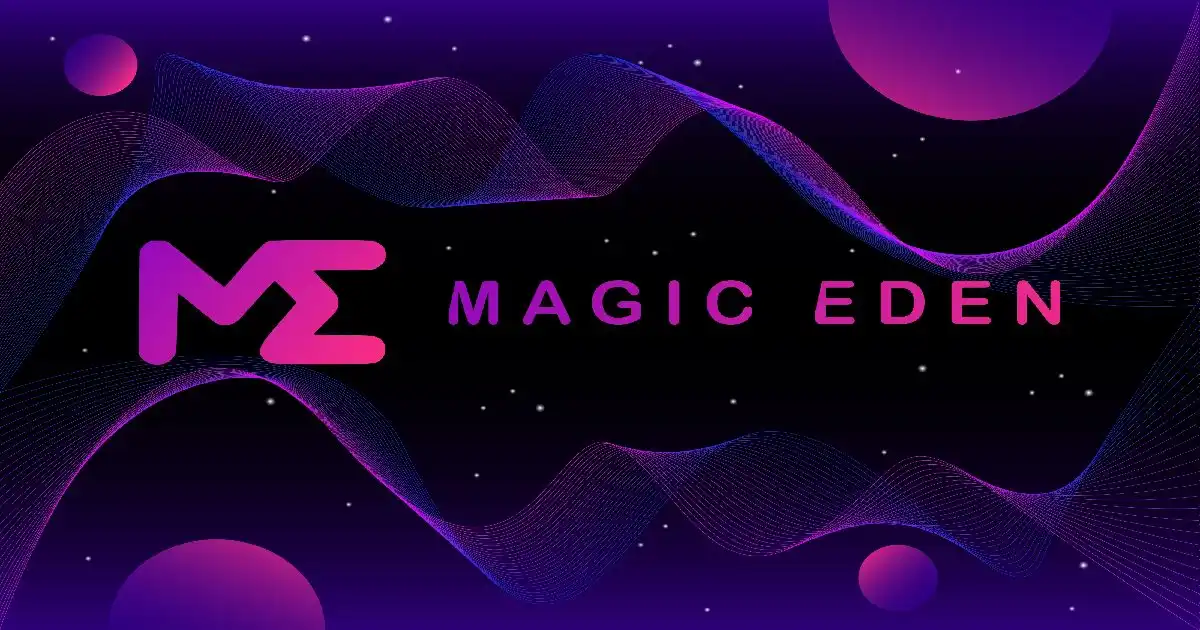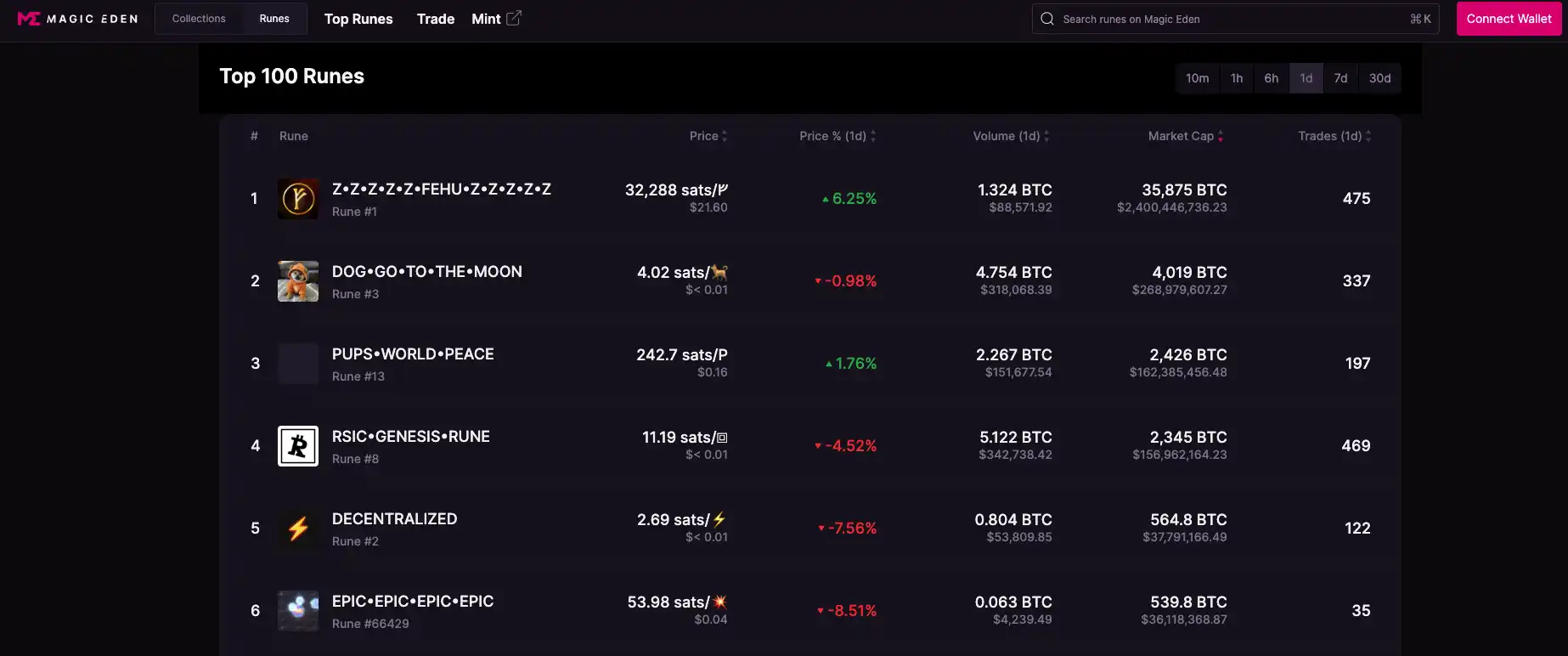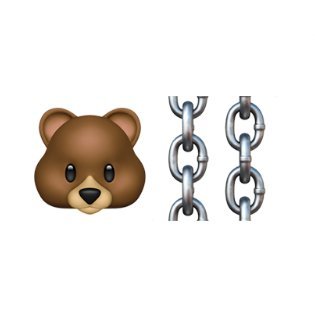原文標題:Zedd:揭開Magic Eden走向市場勝利者的長徵之路
原文來源:Mabel Jiang、HODLong
原文翻譯:Ladyfinger、Lucy、BlockBeats
本文編譯自播客 HODLong,旨在與聽眾一起探討 Web3 社群的發展。對話嘉賓包括計畫營運商、投資者、其他生態系統參與者等,特別關注亞洲的Web3社群。本集節目訪問了Magic Eden聯合創始人Zedd,由HODLong主持人Mabel Jiang主持。 Mabel Jiang曾是Multicoin Capital的合夥人,目前是STPN、Gas Hero、FSL Ecosystem和MOOAR的成長官。
在進入加密貨幣領域之前,Zedd 的早期職業生涯是在貝恩公司為企業客戶提供諮詢服務。隨後在 2017 年,Zedd 加入了 dYdX,這成為他進入加密領域的起點。也是在 dYdX 期間,Zedd 認識了 Mabel Jiang。

Zedd 從 2017 年開始全職從事加密貨幣行業,當時加密貨幣市場生態系統還很小,人們主要在建立一些 DeFi 協議。隨後,Zedd 離開 dYdX,加入 Coinbase 擔任產品經理,在那裡工作了大約一年半,直到 2021 年 9 月創立 Magic Eden。
當時NFT在Solana上非常流行,因此Magic Eden最初專注於Solana市場一年左右。目前,Magic Eden已經滲透到比特幣、Polygon等其他鏈上,尤其是它與比特幣生態系統的緊密聯繫,幾乎使其成為了王者。根據 DappRadar 數據,Magic Eden NFT 市場 24 小時交易額達 676 萬美元,僅低於 Blurs 24 小時交易額 1,593 萬美元,成為交易額第二大 NFT 市場。
Magic Eden最大的優勢在於交易成本極低,為使用者和創作者提供了相比傳統NFT市場更經濟的交易選擇。此外,平台不向創作者收取上幣NFT的費用,這項政策進一步降低了藝術家和創作者進入市場的門檻。本播客討論了 Magic Eden 為探索多鏈市場所做的工作。 BlockBeats將原文翻譯如下:

Magic Eden如何打造多鏈市場?
從 Solana 到 EVM 生態系統
Mabel Jiang:當您決定進入Polygon市場時,您是否考慮過其他選擇?
澤德: 雖然沒有現在那麼多的選擇,但當時我們面前確實有一些選擇。在評估過程中,我們也考慮了Immutable,它在遊戲領域取得了一些成功。同時我們也考慮了Polygon和Avalanche(Avax)。但當時沒有一個平台可以展現出明顯的領先優勢,讓我們覺得必須選擇它,所以每個選擇都伴隨著一定的風險和不確定性。
經過深思熟慮,我們決定選擇Polygon的主要原因是因為許多團隊已經開始在那裡嘗試新項目,而Polygon正在積極與許多遊戲項目進行商業開發合作。所以我們認為這將是一個合適的起點,幫助我們順利進入EVM生態系統。
Mabel Jiang:你們在 Solana 上已經很有影響力,但以太坊和 Polygon 對你們來說是全新的領域。在 Polygon 和以太坊上建構的體驗如何?您最初是如何進入這個生態系的?
澤德: 不得不說,整個過程確實非常具有挑戰性,主要有幾個原因。首先,我們在那個特定時間點推出該產品的決定是一個非常不明智的決定。 FTX 事件發生兩個月後,我們在 Polygon 平台上推出了我們的產品。在FTX事件爆發之前我們就已經開始與Polygon的整合。
不過,Solana 生態也受到了 FTX 事件的影響,導致外界誤以為我們已經放棄了 Solana,但這絕對不是事實。我們面臨的真正挑戰是我們未能有效地傳達我們的願景、計劃以及我們對 Solana 的長期承諾和忠誠。
我們面臨的另一個挑戰是深入了解並融入社區。首先,公司內部需要有更多對EVM和以太坊有深入了解的人才。其次,在這個社區建立影響力比我們想像的困難。雖然我們在 Solana 社群中取得了一定的成功,這給了我們信心,但我們還需要更加努力才能在以太坊社群中獲得同樣的認可。
如果我們要給自己在以太坊社群的初步工作評分,我會說 B,這意味著我們還有改進的空間。我們尚未在以太坊生態系統中取得廣泛的成功,特別是在現有的 NFT 市場之外。
然而,隨著我們在EVM領域工作的不斷深入,我們開始尋找合作的機會。我們與以太坊的資深創建者,如 Yuga Labs、Pudgy 和 Azuki 建立了合作夥伴關係,幫助他們處理版稅和其他問題。這些合作不僅幫助我們更好地融入市場,也逐漸使我們成為真正的多鏈市場參與者。儘管最初的挑戰很大,但透過不懈的努力和策略調整,我們終於在以太坊社群取得了進步。
Mabel Jiang:您能分享一下您與 Yuga Labs 合作的一些細節嗎?我知道你建立了一個 NFT 市場 對於他們來說。這是否類似於白標解決方案?
澤德: 在過去的六個月裡,我們一直與 Yuga Labs 團隊保持持續的溝通,我們之所以保持聯繫,是因為我們的首席遊戲官曾與 Yuga Labs 的前首席遊戲官 Spencer 合作過。透過這段感情,我們也逐漸熟悉了。 Yuga 見證了我們在 Solana 平台上處理版稅的努力。
當現有的以太坊市場決定不再支援版稅時,Yuga 聯繫了我們。然後我們一起討論了是否可以創建一個不僅有利於 Yuga 而且有利於整個創作者生態系統的平台,從而建立了一個尊重版稅的市場,我們在大約四五個月前推出了該市場。基本上,這給了我們在以太坊生態系統中更多的立足點和突破,這是我們之前所缺乏的。
從序數深入比特幣生態系統
Mabel Jiang:您是如何決定建立比特幣市場的?
澤德: 我們舉辦了一次內部黑客馬拉松,十名工程師在加州工作了一周,我們很快就推出了市場。整個過程大約花了三週時間,我們也在開發多鏈錢包,以便資產可以在不同的鏈上進行交換。
Mabel Jiang:您開始在比特幣生態系統中建立東西的過程是怎麼樣的?
澤德: 整個過程真的很瘋狂。 2022 年,Ordinals 協定距離我們還很遙遠。然而,在 2023 年初,我們團隊的一位成員向我們介紹了 Ordinals 協議,一開始我們認為這只是一個理論概念。但很快,我們意識到這項技術是可行的,並且有真正的需求。我們在 Ordinals Discord 頻道中觀察到人們已經開始在那裡進行交易,甚至使用電子表格來完成場外交易。這項活動讓我們確信用戶渴望交易此類資產。
基於這項發現,我們決定建立一個市場。當時,我們不確定是否可以創造一個無需信任、非託管的市場。在這個關鍵時刻,我的共同創辦人 Rex 花了一個週末的時間設計了一個架構,並向我們展示了這個想法是可行的。
江美寶:公司層級為此做了哪些調整?
澤德: 這確實是一個挑戰。我們基本上採用業務單元模式運營,即每條鏈上運營的市場都被視為一個獨立的業務單元。每個單位都配備了專門的產品經理、工程團隊和業務團隊。這種結構保證了工程團隊和業務團隊能夠緊密合作,快速回應市場變化並執行決策。同時,我們也需要確保團隊能夠及時收集用戶回饋,並據此快速迭代產品。
Mabel Jiang:對於 Solana 用戶來說,當他們轉向比特幣時,他們可能需要找到新的錢包擴充或其他方式來使用它。這樣的話,他們會優先使用你的錢包嗎?
澤德: 是的,許多用戶會下載 Magic Eden 錢包,將一些 Sol 轉換為比特幣,然後開始使用 Ordinals。除此之外,還有一些其他的比特幣錢包,像是主要服務中國用戶的OKX和Uniswap,以及同時服務西方和中國用戶的Xverse。這些是 Magic Eden 以外的主要比特幣錢包。
Mabel Jiang:關於比特幣NFT,你們的目標用戶群有什麼特色?
澤德: 我們發現使用比特幣產品的亞洲用戶比 Solana 多得多。另外,我們還有很多使用Solana的用戶也在使用我們的比特幣產品。整個生態系的交叉程度比人們想像的還要多。我們有很多願意嘗試新事物並具有成長心態的用戶。
Mabel Jiang:您認為這些比特幣 NFT 未來會有什麼趨勢?
澤德: 我認為將會創建更多的 NFT Ordinals。這些項目並不是具有實用性的NFT,我認為這實際上是一件好事。姑且稱之為收藏品市場吧,你不需要給它們附加任何實用的功能。這是比特幣上的 NFT 與我們在 Solana 和以太坊上看到的 NFT 之間的主要區別。
現在很多人正在建造圍繞如何鑄造和燃燒序號和符文的工具。還有很多人試圖尋找其他方法來簡化這些交易,因為在比特幣 L1 上進行交易顯然更加困難。當您交易 Solana meme 幣然後去 Ordinals 時,就像去 SPA 一樣。
Mabel Jiang:您能快速解釋一下什麼是符文和 NFT 以及它們之間的差異嗎?
澤德: Ordinals 基本上可以看作是 NFT,它與 ETH 和 SOL 上的 NFT 不同,後者實際上是直接在鏈上刻錄媒體或資料。 BRC 20和符文基本上是不同的FT標準。其實還有更多例如BRC 420等等,但主要的是BRC 20和符文。
Runes 非常新,只有大約三到四個星期的歷史,而 BRC 20 已經出現了將近一年。 Runes 有點像 BRC 20 的更用戶友好的版本,不需要一些雕刻活動來轉移它們。 Runes 也是由開發 Ordinals 協議的同一團隊開發的。有一個小團隊致力於 Ordinals 的核心開發,這也是 Runes 受到大量關注和炒作的原因之一。

Mabel Jiang:你們有建過DEX嗎?
澤德: 我們實際上正在與 Exodus 合作。用戶可以透過Magic Eden錢包將Sol、ETH、比特幣等兌換成USDC。
Mabel Jiang:您有考慮過自己建造L2嗎?
澤德: 我們現在確實沒有足夠的資源來處理這個問題。如果一定要談比特幣L2,我們只會考慮建構一個原生的比特幣L2,而不是現在這些所謂的L2。因為它們顯然不是原生的比特幣L2,只是為了敘述而稱自己為比特幣L2,這其實更像是比特幣側鏈。
Mabel Jiang:未來有計劃擴大對其他區塊鏈的支援嗎?
澤德: 我們正在密切關注市場,雖然我們沒有積極開發它,但我們注意到 EVM 鏈上沒有太多活動。同時,我們也在關註一些正在自建鏈的項目。
如何深入了解並融入社會?

針對買家的激勵措施
Mabel Jiang:Blur在流動性激勵方面似乎取得了不錯的效果。您如何看待與他們的競爭?
澤德: 由於我們還沒有進入以太坊領域,所以對平台上的動態沒有太多感知。我們的核心關注點是用戶的實際使用情況,而不是純粹的交易量,因為交易量指標很容易受到激勵的影響。我們更專注於分析用戶活躍度和實際收入。
Blur 在激勵流動性方面做得很好,我們認為這是一個明智的策略。但我們始終認為,我們追求的平台不應該只依賴流動性激勵。我們更喜歡關注用戶活動和收入,因為這些指標更能反映平台的健康狀況。此外,我們也意識到,過度依賴交易量作為指標可能存在風險。
Mabel Jiang:你們在Magic Eden上實施的交易獎勵遊戲化策略效果如何?
澤德: 我們實施了一種名為鑽石的獎勵,效果非常好。我們的初衷是探索多種方式來激勵和獎勵用戶,而不是把它變成純粹的零和遊戲。特別是在比特幣市場,我們的獎勵和激勵主要是針對買家的,這樣做的目的是鼓勵人們購買NFT。我們不希望所有的激勵措施都對賣家有利,因為這樣做可能會導致底價受到不利影響。我們的目標是創造一個更健全、更健康的市場環境。
Mabel Jiang:在遊戲領域,我們注意到Magic Eden做了很多努力,特別是在過去的一年。您如何評估這些努力的有效性?在這個過程中,有哪些值得分享的經驗與啟發?
澤德: 自2022年底以來,我們已經組建了四人左右的遊戲團隊,主要以業務發展為驅動。團隊的主要任務是與遊戲專案合作,協助遊戲專案上線NFT,並提供市場使用方面的支援。回顧過去的18個月,我們發現這是一次非常有趣的經驗。 2021年和2022年初,遊戲產業經歷了一波炒作。不過,這一年半的時間裡,不少遊戲團隊都以深耕為主,市場上並沒有太多新的活動。
此外,我們還面臨另一個挑戰,那就是從產品和工程的角度來看,每個遊戲專案所需的基礎設施都非常客製化,我們還沒有為每個遊戲提供足夠深度的客製化支援。這意味著我們仍然需要付出更多的努力來理解和滿足每個遊戲項目的獨特需求。
建立強大的本土社區
江美寶:您在建立和培育本土社區方面採取了哪些有效措施?
澤德: 為了建立強大的原生社區,我們採取了幾項關鍵措施。首先,我們確保公司內部有能夠代表和理解社區文化的成員,這一點至關重要。其次,我們非常注重與社群的溝通和社群媒體互動,保持社群的活躍度和參與度。
三是積極舉辦線下活動。無論哪次會議,我們都會組織相關活動,加強與社區成員的聯繫。最後,我們從過去的錯誤中學習並不斷改進,這顯著加強了我們與社區的關係。透過這些努力,我們與社區的聯繫比以往任何時候都更加緊密。
Mabel Jiang:這些年來你們的用戶群有改變嗎?
澤德: 除了地理位置外,沒有太大變化。現在使用比特幣的人數比兩年前多得多。
Mabel Jiang:你們現在的團隊有多大?
澤德: 約100人。
Mabel Jiang:您的比特幣用戶來自亞洲,對您來說代表什麼?您想擴大在亞洲的社區嗎?
澤德: 我們有許多 Solana 用戶也在使用我們的比特幣產品,這說明了我們用戶的交叉性質。我們目前並沒有專門在亞洲建立一個社區,但這是我們希望實現的目標。
Mabel Jiang:如何建立一個沒有母語團隊成員的社群?
澤德: 我承認這確實很難,我們目前還沒有真正在亞洲建立一個社區。我們需要找到合適的人,然後投入資源來實現這個目標。如果有人對 NFT 和我們的產品充滿熱情,並願意在亞洲發展社區,我們很樂意與他們交談。
本文源自網路:對話Magic Eden共同創辦人:只會考慮原生比特幣L2,多鏈市場誘因應面向買家
簡而言之,鯨魚利用上次下跌的機會累積了 ADA,但這種累積在過去一周已經穩定下來。持有 ADA 的短期交易者數量正在下降,這可能會導致價格波動性降低。 EMA 線顯示出盤整模式,但短期內有可能出現金叉。鯨魚利用最近的下跌來累積卡爾達諾(ADA),導致上週 ADA 的價格明顯穩定。這一累積期恰逢持有 ADA 的短期交易者減少,顯示價格波動性可能下降。同時,ADA 價格的 EMA 線呈現盤整格局,暗示市場均衡。儘管如此,人們預計在不久的將來會出現金叉,這是一個通常與看漲相關的技術訊號…







